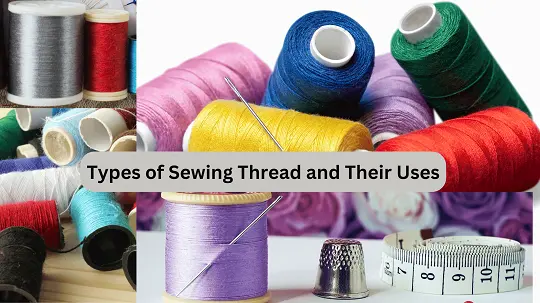Types of Sewing Thread and Their Uses
Sewing threads are used for the sewing process. Sewing thread is the most important trimming that is extensively used in garment manufacturing. The correct selection of sewing thread requires consideration of its overall performance properties for the duration of sewing as well as its performance within the completed garment under conditions of wear and cleaning. In this article, we discuss the Types of Sewing Thread and Their Uses in the Textile and apparel industry.

Sewing threads are composed.
- Fiber Types
- Thread construction and
- Thread finish
Fiber types:
- Linen
- Silk Thread
- Cotton Thread
- Soft Cotton Thread
- Mercerized cotton thread
- Glanced Cotton thread
- Viscose thread,
- Polyester thread,
- Nylon thread,
- Aramid thread,
- PTFE thread.
Linen thread:
Linen was once used much more than it is now for making strong garments, rather stiff threads
for heavy seaming and also for button sewing; however, it has been largely outdated by synthetic threads
Silk thread:
Silk sewing thread is made each as the continuous filament extruded by the silkworm and as broken filaments spun into a yarn. It has a good appearance and performance but its high cost is high. Its only common use in higher quality manufacturing garments.
Cotton
The natural fiber used most frequently is cotton. Cotton threads in standard provide exact stitching performance however their strength and abrasion resistance are inferior to synthetic threads of same thickness Cotton threads are greater solid at higher, dry temperatures than are artificial threads,
and are therefore less affected by hot needles at some point of stitching unless special lubricant precautions are taken with the artificial threads.
Soft cotton:
Soft cotton threads usually have a high wet shrinkage, which may cause pucker in seams after washing.
Mercerized cotton thread:
This type of thread is finished by caustic soda solution with the tension of caustic soda, which
reasons the fibers to swell and come to be rounder in cross-section. The end result is a thread with and better tenacity.
Glace cotton thread:
Glacé cotton threads are created from soft cotton threads which have been consolidated and protected by the application of a special surface coating. This produces a stiffer thread with a smoother surface and higher resistance to abrasion than soft cotton.
Viscose thread:
They do no longer have the strength or durability of synthetic fibers and they have low elasticity and low energy wet, but their great advantage is their high luster for use in embroidery. Garments incorporating them should no longer go through repeated washing.
Synthetic threads:
Synthetic stitching threads are made especially from polyester and polyamide (nylon). All synthetic fibers begin life as continuous filaments. Synthetic threads are not considerably affected by rot, mold, or bacteria. They have high tenacities, especially in non-stop filament form, and also have high resistance to abrasion.
Polyester thread:
Polyester is taken into consideration the great fiber for maximum sewing thread applications, having a low cost, high strength, suitable chemical properties, favorable elastic characteristics, and correct dye fastness.
Nylon thread:
Nylon thread has a high strength to a fineness of polyester but less favorable extension characteristics. Nylon thread used knitted fabric and swimming.
Aramid thread:
Aramide threads are not used at a large rate because of the greater expensive.it is very costly. Its name is Nomex.
PTFE sewing thread:
PTFE sewing threads very highly-priced but they have a few professional industrial makes use of where their whole non-flammability, non-melting property, and high resistance to chemicals make them important.
These are the sewing threads commonly used for garment manufacturing all over the world.
- You may love to read: Difference between Yarn and Thread
- 10 Properties of Sewing Thread Used for Clothing
- Different Types of Sewing Thread Packages


